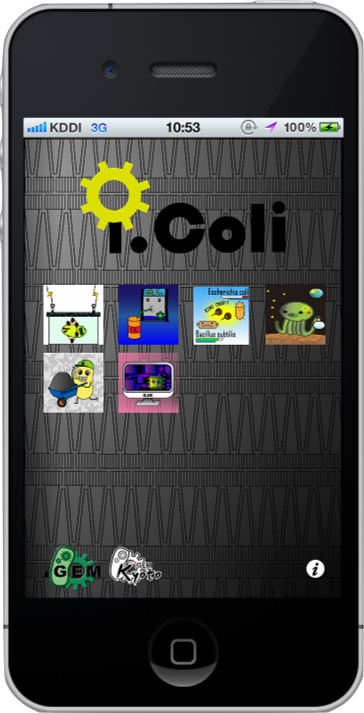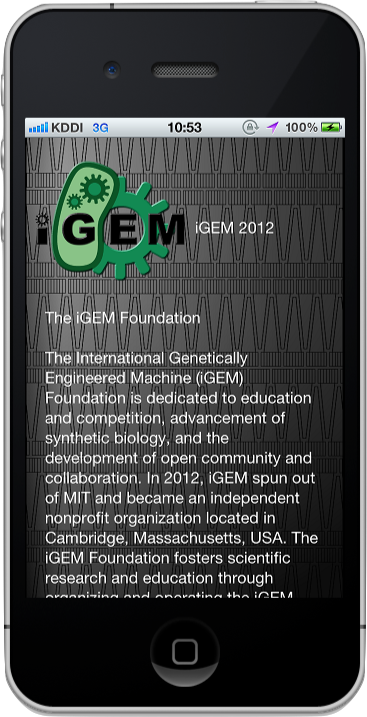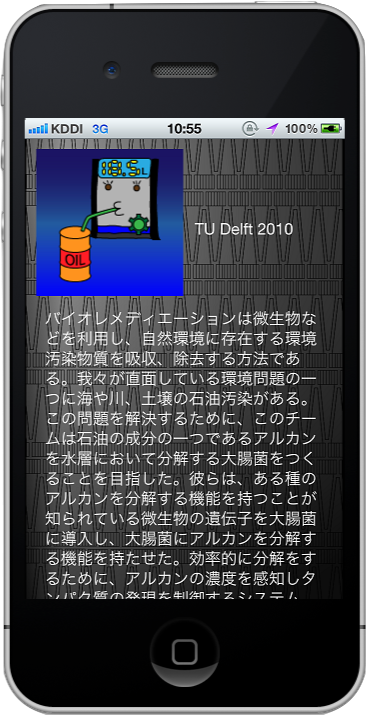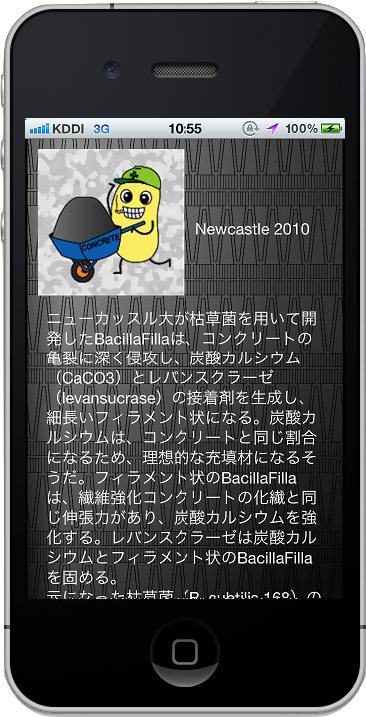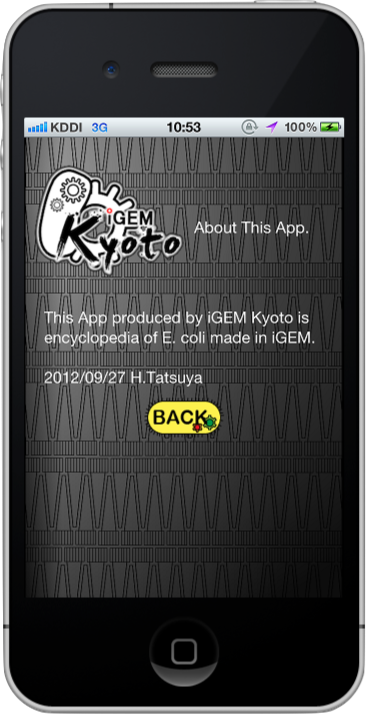Team:Kyoto/Consideration
From 2012.igem.org
(→Consideration) |
(→This year, we implemented nine plans on "human practice".) |
||
| (296 intermediate revisions not shown) | |||
| Line 1: | Line 1: | ||
| - | [[Image:Header_Kyoto_not_home.jpg|975px]] | + | [[Image:Header_Kyoto_not_home.jpg|975px|link=Team:Kyoto]] |
{{Kyoto/header}} | {{Kyoto/header}} | ||
| - | + | <html> | |
| - | < | + | <script type="text/javascript"> |
| + | $(function() { | ||
| + | showTab("kyoto-tab-HumanPractice"); | ||
| + | }); | ||
| + | </script> | ||
| + | </html> | ||
| - | + | <ul id="kyoto-tabs"> | |
| - | + | <li><html><a href="" onclick="showTab('kyoto-tab-HumanPractice'); return false;"></html>[[Image:KyotoTab_HumanPractice.png|link=|HumanPractice]]<html></a></html></li> | |
| - | + | <li><html><a href="" onclick="showTab('kyoto-tab-Safety'); return false;"></html> | |
| + | [[Image:KyotoTab_Safety.png|link=|Safety]]<html></a></html></li> | ||
| + | <li><html><a href="" onclick="showTab('kyoto-tab-Acknowledgement'); return false;"></html>[[Image:KyotoTab_Acknowledgement.png|link=|Acknowledgement]]<html></a></html></li> | ||
| + | </ul> | ||
| + | <div id="kyoto-tab-contents"> | ||
| + | <div id="kyoto-tab-HumanPractice"> | ||
| + | =[[File:Kyoto_HumanPractice.png|link=]]= | ||
| + | |||
| + | ===This year, we implemented nine plans on "human practice".=== | ||
| + | |||
| + | Our purpose of these projects is that we let many Japanese people know iGEM and participate in it. | ||
| + | This is why we implemented nine projects. | ||
| + | In order to achieve our purpose, we gave many people lessons the correct knowledge about Genetic Engineering and eliminate the bias toward it at many places. | ||
| + | Besides, we attempted to communicate with local people who live in Kyoto through teaching science, synthetic biology, and "iGEM". | ||
| + | |||
| + | Especially, we gave high priority to two programs, "Making iPhone app" and "Educational program" | ||
| + | |||
| + | The first project is that we created an iPhone app to let many Japanese know synthetic biology. This is because some Japanese people seem to have a bad impression for gene recombination, so we want to modify this bias. In addition, the number of the Japanese who know what gene recombination is still small, so we would like to show how wonderful recombination is to them.<br> | ||
| + | |||
| + | The second project is to introduce the synthetic biology to high school students, as we would like many high school students to participate in iGEM. This summer, we carried out lectures about gene recombination and biochemistry in "Seiryo festival" at Hibiya high school; furthermore we held a poster session in open campus of Kyoto university.<br><br> | ||
Due to the curriculum in our country, it is rather difficult for high school students to take part in iGEM undergraduate category, so we decided to tell them about the HS division and support students who are interested in it. There will probably be many teams from Japan in the next iGEM HS division. | Due to the curriculum in our country, it is rather difficult for high school students to take part in iGEM undergraduate category, so we decided to tell them about the HS division and support students who are interested in it. There will probably be many teams from Japan in the next iGEM HS division. | ||
| - | + | ==Application== | |
| - | + | [[File:Kyoto_iColi0_7.png|left|250px]] | |
| - | + | [[File:Kyoto_iColi0_1.png|80px]] | |
| - | + | [[File:Kyoto_iColi0_2.png|80px]] | |
| - | + | [[File:Kyoto_iColi0_5.png|80px]] | |
| + | [[File:Kyoto_iColi0_6.png|80px]] | ||
| + | [[File:Kyoto_iColi0_3.png|80px]] | ||
| + | This year we created an iPhone app named "iColi" that is aimed to let many Japanese know synthetic biology and bring it closer to the non-English speakers in Japan by presentation of an example of gene recombination made by iGEMers. "iColi" is an encyclopedia of E. coli made in iGEM. This application contains not only the details of gene recombination but also the list of genes and awards the teams won. Furthermore, it includes the explanation about each theme.<br> | ||
| + | |||
| + | Nowadays most Japanese people don't know about synthetic biology and details of gene recombination, even though there are many genetically-modified crops in Japan, and they often criticize it with poor knowledge. Then we want to make this situation better.<br> | ||
| + | |||
| + | <font size="6">This is why we create "iColi".</font> | ||
| + | |||
| + | We think "iColi" will be one of ways to let Japanese people know what synthetic biology is. This app introduces the understandable characters that were presented in the past iGEM competition and "Flower Fairy E.coli", furthermore this app contains the description of each characters. <br> | ||
| + | |||
| + | We already made it complete, and are preparing to release this app in "App Store" on November. | ||
| + | <br clear="both" /> | ||
| + | |||
| + | ==Education== | ||
| + | [[File:KyotoLecture.jpg|link=|right|300px]] | ||
| + | We went to Hibiya high school and Horikawa high school, and then we gave a short introduction on synthetic biology and iGEM, including the attractive points of synthetic biology, the ways of changing living things by reconstructing their genes and activities of other undergraduate iGEM teams. | ||
| + | |||
| + | In Japan, most high school student was not able to learn about synthetic biology and details of gene combination due to a regular curriculum of high school. This is why we decided to let them know how to conduct the experience, what synthetic biology is, and what iGEM is. | ||
| + | |||
| + | Furthermore we met some eager junior high school students, so we added a brief explanation about biochemistry, especially genes, nucleotide, codon and the basic system of gene expression. | ||
| + | |||
| + | We used [[Team:Kyoto/Education|these slides]] in order to teach synthetic biology. | ||
| + | |||
| + | <br style="clear: both;" /> | ||
| + | |||
| + | ==The 3rd international symposium on liberal arts and general education== | ||
| + | [[File:article2.jpg|link=|right|300px]] | ||
| + | <font size="5">We wrote an article about "Japanese Attitude toward Genetic Engineering" </font> | ||
| + | |||
| + | and presented it in the 2nd International Symposium on Liberal Arts and General Education which took place at Clock Tower Centennial Hall in Kyoto University, on November 23, 2011. | ||
| + | Many people starve to death because they are unable to grow enough crops in their impoverished countries. Food shortage has become one of the most serious problems in the world. Some people expect that genetic engineering can solve this problem because genetically modified plants can grow more easily in barren land . | ||
| + | However, some people worry that genetically modified foods may do harm to our health and the environment. It is often reported that Japanese people tend to avoid genetically modified foods. Sure enough, previous surveys of attitudes toward genetic engineering showed that, in Japan, more people had “negative” or “neutral” opinions regarding genetically modified foods than people in other nations. | ||
| + | These findings piqued our interest in the Japanese public’s views on genetic engineering and made clear to us the importance of active discussion on the subject of genetic engineering. In conjunction with other university students in Japan, we designed questionnaires asking for subjects’ impressions of genetic engineering and carried out a nationwide survey in order to clarify the reasons for Japanese people’s attitudes toward the subject . | ||
| + | In this paper, we suggest that educational differences have created a gap between the attitudes of students and adults of their parents generation. | ||
| + | read more:[[File:ENGLISH.pdf|link=|right|300px]] | ||
| + | <br style="clear: both;" /> | ||
| + | |||
| + | ==Walk-in science== | ||
| + | [[File:Walkincampus.jpg|link=|left|300px]] | ||
| + | [[File:BioBrickBlocks.jpg|link=|center|380px]] | ||
| + | The Faculty of Science, Kyoto University, held "Walk-in Science," a science communication event at Kyoto City Hall Station in February 25 & 26. | ||
| + | We iGEM Kyoto also joined it and ran a booth of synthetic biology. | ||
| + | |||
| + | <br><br>Today, it is a problem in Japan that more young people are moving away from the sciences. Hence, it is important to let people, especially children, know more about sciences. | ||
| + | "Walk-in Science" was an event to show what we study, how interesting sciences are, to people who walk in non-academic place. "Walk-in Science" joiners had booths on the street of the underground mall. | ||
| + | |||
| + | To walkers of all ages who live in Kyoto, we told what Biobrick is, with "BioBrick Blocks". | ||
| + | Although most of them did not know about biotechnology, everyone listened to our speech and enrich their understanding. | ||
| + | <br style="clear: both;" /> | ||
| + | |||
| + | ==Kyoto University Academic Day == | ||
| + | [[File:Academicday2.jpg|link=|right|300px]] | ||
| + | Kyoto University Academic Day is a place of communication that anyone can notice the attractiveness of learning fun regardless of Citizens and researchers. | ||
| + | |||
| + | The main purpose of this event is to reflect public opinion in national policy and research activities in the university. | ||
| + | |||
| + | Actually we used a poster and a screen to tell how to conduct an experiment of gene recombination, what "iGEM" is, and our results of research to children, housewives, teachers, and so on, then we could communicate and explain it with the people who don't know about "iGEM". | ||
| + | |||
| + | After our presentation many people said "I have had a bad impression on gene recombination and gene modified crops but today I heard the possibility of gene recombination and Synthetic biology, then I change my root thought about it" | ||
| + | |||
| + | |||
| + | |||
| + | <br style="clear: both;" /> | ||
| + | |||
| + | ==November Festival and Open Campus at Kyoto University== | ||
| + | [[File:opencampus.jpg|link=|left|300px]] | ||
| + | Kyoto University has some big events for people out of our university. | ||
| + | We iGEM Kyoto joined two of those events: November Festival(NF) and Open Campus. | ||
| + | |||
| + | November Festa. is one of the biggest college festivals in West-Japan. | ||
| + | It is held in 4 days, and many people of all ages come not only from Kyoto City but also from far away. | ||
| + | In this festa. we presented what our team does in iGEM 2011 with a poster. | ||
| + | We also explained what synthetic biology and iGEM are. | ||
| + | |||
| + | Kyoto University's Open Campus was held in August 9 & 10. | ||
| + | Many high school students visited our univ. | ||
| + | We talked with them about iGEM as one of the activities which college students can join. | ||
| + | We believe that some of them will join iGEM in the future. | ||
| + | <br style="clear: both;" /> | ||
| + | |||
| + | ==Science Agora== | ||
| + | [[File:scienceagora.jpg|link=|right|400px]] | ||
| + | "Science agora" is the biggest event in Japan about science. Last year, we exhibited our results of research that we created "carnivorous E.coli" and "Flower Fairy E.coli" as a member of iGEM Japan. | ||
| + | In Science agora, a variety of people with various backgrounds were there. | ||
| + | Many children learned about synthetic biology here, and we communicated with many people. | ||
| + | |||
| + | <br style="clear: both;" /> | ||
| + | |||
| + | ==Tie-up with Super Science High school== | ||
| + | |||
| + | [[File:highschool.jpg|link=|left|300px]] | ||
| + | <br style="clear: both;" /> | ||
| + | <font size ="4">We began to communicate with students and teachers of Toyonaka high school.</font> | ||
| + | Toyonaka high school is authorized Super Science High School by Ministry of Education, Culture, Sports, Science and Technology, and conduct a policy that they will increase the number of students who learn university-level education in biology. | ||
| + | As a one of the program, we decided to conduct the lecture that let them get into synthetic biology and experimental technique. | ||
| + | We will be having the lecture about synthetic biology for three days in November. | ||
| + | We thought this activity has several meaning that we are able to encourage regional development of science and technology and diffuse synthetic biology. | ||
| + | We would like to continue a communication like this.<br> | ||
| + | |||
| + | ==Cooperation -a meeting in iGEM Japan- == | ||
| + | [[File:igemjapan.jpg|link=|left|300px]] | ||
| + | In Japan, there are more than 10 teams, so communication with other Japanese teams is very important to make our activities better. This summer, we held a meeting of iGEM Japan at Tokyo Metropolitan University. Each team presented and discussed its theme with other teams. Moreover we held an online meeting among iGEM teams in Japan and practiced presentations. | ||
| + | <br style="clear: both;" /> | ||
| + | |||
| + | ==Cooperation with KAIT_Japan on issues of safety. == | ||
| + | [[Team:KAIT_Japan|KAIT_Japan]] has an issue of safety. When we were trying some program which could make our research safer, we got their proposal about safety. They performed "Safety Icon Project".In this project, they designed icons in safety, which you could tell whether the parts in registry were safety or not at a glance. You can see the explanation of the icons and their meanings [[Team:Kyoto/Cooperation Program|here]]. | ||
| + | <br style="clear: both;" /> | ||
| + | |||
| + | |||
| + | ---- | ||
| + | </div> | ||
| + | <div id="kyoto-tab-Safety"> | ||
| + | |||
| + | =[[File:Kyoto_Safety.png|link=]]= | ||
| + | |||
| + | '''Q1. Would any of your project ideas raise safety issues in terms of: researcher safety, public safety, or environmental safety'''? | ||
| + | |||
| + | We use the following creatures and genes. | ||
| + | |||
| + | ・Creatures | ||
| + | *''Arabidopsis thaliana'' | ||
| + | *''Escherichia coli | ||
| + | '' | ||
| + | ・Genes | ||
| + | *TatABCD operon | ||
| + | *TAMO reductase | ||
| + | *TorA signal | ||
| + | *pspA | ||
| + | *kil | ||
| + | *FLOWERING LOCUS T | ||
| + | *others in iGEM Parts Kit | ||
| + | FLOWERING LOCUS T is derived from ''Arabidopsis thaliana'' and other all genes expect for iGEM Parts Kit are derived from ''E.coli''. All experiments are conducted under the Biosafety level 1 control. All of rubbish containing recombinant ''E.coli'' is not carried out of our Lab before being sterilized. We always take care to lock the door of our Lab when there is no person so that the possibility that someone goes into our Lab and takes away recombinant cells is very low. | ||
| + | |||
| + | We are trained in applicable lab safety to ensure researcher safety and environmental safety. The researchers have also been trained in proper usage of chemicals and equipment. Some of the biological reagents and experiments necessary for the project needed safety measures. They were; Ethidium Bromide (EtBr), phenol, chloroform, 3,5-dinitrosalicylic acid, gas burner, ultra violet LED, polyacrylamide, 2-mercaptoethanol, PFA. Therefore, all researchers keep following rules when we use the chemicals or equipment above. | ||
| + | * EtBr (Ethidium bromide): EtBr is regarded as a mutagen, carcinogen or teratogen. Lab members were briefed on the possible effects of EtBr. During the experiments, we wore gloves. After use, the gloves and gel were separately disposed. | ||
| + | * Phenol and 3,5-Dinitrosalicylic Acid: Phenol and its vapors are corrosive to eyes, skin, and respiratory tract. 3,5-Dinitrosalicylic acid can cause serious irritation to eyes. These were handled under the draft chamber. | ||
| + | * Chloroform: Chloroform is a possible carcinogen. To avoid unnecessary exposure, this was also handled under the draft chamber. | ||
| + | * Gas Burner: We used gas burners and heated the air around the workspace to raise the temperature, thereby reducing contamination. Although the gas burner is a common combustion apparatus we are all familiar with, it can cause a massive disaster if used improperly. We made all-out efforts to keep all the flammable items away from the flame and not to pass behind a person who is using a gas burner. | ||
| + | * Ultra Violet LED: Ultra violet (UVB) is harmful to eyes. Hence, the LEDs were lit only inside the cardboard box and we only look at it to check if it is properly lit to avoid long exposure. | ||
| + | * polyacrylamide, 2-mercaptoethanol: We used these reagents for Western Blotting. They are toxic even though they are necessary to check the expression of target proteins so we asked for advice on how we should store them and obeyed the rules of Kyoto University. | ||
| + | * PFA: These reagents are used to microscope ''E.coli'' by Confocal laser scanning microscopy. This is usually stored in Prof. Agata’s Laboratory | ||
| + | |||
| + | '''Q2. Do any of the new BioBrick parts (or devices) that you made this year raise any safety issues?''' | ||
| + | |||
| + | * NO. Currently we have no BioBrick which raises any safety issues. The BioBricks we made this year are derived only from lab-safe strains of Arabidopsis thaliana and ''E.coli''. | ||
| + | |||
| + | |||
| + | '''Q3. Is there a local biosafety group, committee, or review board at your institution?''' | ||
| + | |||
| + | Yes. We submitted the experiment plan to the Environment, Safety, and Health Organization, Kyoto Univ. (http://www.esho.kyoto-u.ac.jp/index.php) and were allowed to operate genetic modification of the bacteria under the Biosafety level 1(. Experiments were planned following the safety guidelines of the university (http://www.esho.kyoto-u.ac.jp/wp-content /uploads/2008/05/25_01.pdf). These guidelines are based on national laws and this includes several regulations on GMOs (http://www.bch.biodic.go.jp/hourei1.html). We carried out our experiments in the students-laboratory of the Graduate School of Science / Faculty of Science, Kyoto Univ, which has its own department for safety and environment. All of the lab members received training for PCR, culture of cells, miniprep and etc., the minimal genetical operations and use of autoclave. | ||
| + | |||
| + | '''Q4. Do you have any other ideas how to deal with safety issues that could be useful for future iGEM competitions? How could parts, devices and systems be made even safer through biosafety engineering?''' | ||
| + | |||
| + | IGEMers should set up a common clear biosafety regulation in iGEM competition and establish a systematic guideline of education about biosafety. This education should include information about biohazard and biotechnology risk assessment and risk analysis. | ||
| + | |||
| + | Backgrounds of iGEMers have become wider and wider, from high school students to graduate student in biology and from major in physics to major in molecular biology. For some students, iGEM is the first contact to genetic engineering and they have little knowledge of biohazard and importance of biosafety. Each iGEM teams, of course, teaches the knowledge to their members. However, a systematic education way of biosafety will help students to understand biosafety and to conduct their experiments more adequately. | ||
| + | |||
| + | From these reasons, we recommend that iGEM establish a systematic guideline of education about biosafety. | ||
| + | |||
| + | |||
| + | |||
| + | '''We work together with [[Team:KAIT_Japan|KAIT_Japan]] on issues of safety.''' | ||
| + | |||
| + | Cooperatively with KAIT_Japan, We iGEM Kyoto placed icons on our Wiki, which immediately enable you to see a risk of parts. The icons are as follows: | ||
| + | |||
| + | *Bio safety level 1:http://partsregistry.org/Image:Biosafety_Level1.png | ||
| + | *Bio safety level 2:http://partsregistry.org/Image:Biosafety_Level2.png | ||
| + | *Bio safety level 3:http://partsregistry.org/Image:Biosafety_Level3.png | ||
| + | *cases which affect biological community: http://partsregistry.org/Image:Biocenosis.png | ||
| + | *cases which affect the environment: http://partsregistry.org/Image:Environment.png | ||
| + | *cases which affect human bodies: http://partsregistry.org/Image:Humanbody.png | ||
| + | *cases which includes a certain risk because of mutations: http://partsregistry.org/Image:Mutation.png | ||
| + | |||
| + | *safe: http://partsregistry.org/Image:Safety.png | ||
| + | </div> | ||
| + | <div id="kyoto-tab-Acknowledgement"> | ||
| + | |||
| + | =[[File:Kyoto_Acknowledgement.png|link=]]= | ||
| + | |||
| + | '''iGEM Kyoto 2012 team wouldn't have been able to do much without the lots of support of great advice and attributions. Thank you very much from the bottom of our heart.'''<br><br> | ||
| + | |||
| + | '''Thank you for providing lots of advice on techniques and helping us to solve scientific problem.'''<br> | ||
| + | |||
| + | *Knut Woltjen<br> | ||
| + | Center for iPS Cell Research and Application(CiRA). Kyoto University<br> | ||
| + | *Humihiko Satou<br> | ||
| + | Graduate School of Biostudies. Kyoto University<br> | ||
| + | *Takayuki Kouchi<br> | ||
| + | Graduate School of Biostudies. Kyoto University<br> | ||
| + | *Toru Matou & Masaru Kobayashi<br> | ||
| + | Faculty/Graduate School of Agriculture<br> | ||
| + | *Takashi Endou<br> | ||
| + | Faculty/Graduate School of Agriculture<br> | ||
| + | *Tan Inoue<br> | ||
| + | Graduate School of Biostudies. Kyoto University<br> | ||
| + | *Ken Kajita | ||
| + | Faculty of Engineering. Kyoto University<br> | ||
| + | *Tatsuya Hirose | ||
| + | Faculty of Science. Kyoto University<br><br> | ||
| + | '''Thank you for letting us use laboratory and seminar room over the summer vacation and use freely expensive laboratory equipment.'''<br> | ||
| + | |||
| + | *Kyoto University Committee, Faculty of Science Building #2<br><br> | ||
| + | |||
| + | |||
| + | == Attribution == | ||
| + | <br> | ||
| + | |||
| + | '''Thank you for providing of Flower Locus T Plasmid.'''<br> | ||
| + | |||
| + | *Takashi Araki<br> | ||
| + | [http://www.lif.kyoto-u.ac.jp/labs/plantdevbio/index.html Laboratory of Plant Deveropmental Biology]<br> | ||
| + | 2007 Plant Developmental Biology, Graduate School of BIOSTUDIES, Kyoto-Univ.<br><br> | ||
| + | |||
| + | '''Thank you for providing of Arabidopsis thaliana.'''<br> | ||
| + | *Tetsuro Okuno<br> | ||
| + | Graduate School of Agriculture, Kyoto Univ.<br> | ||
| + | *Kojiro Takanashi<br> | ||
| + | Research Institute for Sustainable Humanosphere, Kyoto Univ.<br> | ||
| + | *Sota Fujii<br> | ||
| + | Graduate School of Science, Kyoto Univ.<br> | ||
| + | *Toshiharu Shikanai<br> | ||
| + | Graduate School of Science, Kyoto Univ.<br><br> | ||
| + | |||
| + | '''Thank you for providing of reagents.''' | ||
| + | *Yasuo Mori<br> | ||
| + | Graduate Scholl of Engineering, Kyoto Univ.<br><br> | ||
| + | |||
| + | '''Thank you for providing of MilliQ and EtBr.'''<br> | ||
| + | *Tokitaka Oyama<br> | ||
| + | Department of Botany, Graduate School of Science, Kyoto Univ.<br><br> | ||
| + | |||
| + | '''Thank you for providing of Arabidopsis thaliana and Syringe. '''<br> | ||
| + | *Ikuko Nishimura<br> | ||
| + | Department of Botany, Kyoto Univ | ||
| + | *Tomonori Takada<br> | ||
| + | Department of Botany, Kyoto Univ<br><br> | ||
| + | |||
| + | '''Thank you for providing us of Arabidopsis thaliana. '''<br> | ||
| + | *Ikuhiko Nakase<br> | ||
| + | Graduate School of Pharmaceutical Sciences, Kyoto-Univ.<br><br> | ||
| + | |||
| + | '''Thank you for your supervising of our using confocal microscope and liquid nitrogen.'''<br> | ||
| + | *Makoto Kashima<br> | ||
| + | Graduate School of Science, Kyoto Univ<br><br> | ||
| + | |||
| + | '''Thank you for your supervising of our purification of protein.'''<br> | ||
| + | *Wataru Shihoya<br> | ||
| + | Cellular and Structural Physiology Institute, Nagoya University<br><br> | ||
| + | |||
| + | =[[File:Kyoto_Sponsors.png|link=]]= | ||
| + | '''Kyoto University''' is our school and supports us.<br> | ||
| + | [[File:KUlogo.jpg | link=http://www.kyoto-u.ac.jp/|]]<br><br><br> | ||
| + | '''Integrated DNA Technologies (IDT), Japanese branch, Medical & Biological Laboratories Company (MBL), Leave a Nest''' supported us.<br> | ||
| + | [[File:IDTLogo2010.png | link=http://www.idtdna.com/site]]<br> | ||
| + | [[File:MBLlogo.gif | link=http://www.mbl.co.jp/e/index.html]]<br> | ||
| + | [[File:Leave_a_Nest.jpg | link=http://www.cactus.co.jp/aboutus/partners.html]]<br><br><br> | ||
| + | '''CosmoBio''' supported us financially.<br> | ||
| + | [[File:CosmoBio.jpg | link=http://www.cosmobio.co.jp/]]<br> | ||
| + | </div> | ||
| + | <div id="kyoto-tab-Criteria"> | ||
| - | |||
| - | |||
[https://igem.org/2012_Judging_Form?id=797 Criteria] | [https://igem.org/2012_Judging_Form?id=797 Criteria] | ||
| + | |||
| + | </div> | ||
| + | </div> | ||
{{Kyoto/footer}} | {{Kyoto/footer}} | ||
Latest revision as of 03:57, 27 October 2012
This year, we implemented nine plans on "human practice".
Our purpose of these projects is that we let many Japanese people know iGEM and participate in it. This is why we implemented nine projects. In order to achieve our purpose, we gave many people lessons the correct knowledge about Genetic Engineering and eliminate the bias toward it at many places. Besides, we attempted to communicate with local people who live in Kyoto through teaching science, synthetic biology, and "iGEM".
Especially, we gave high priority to two programs, "Making iPhone app" and "Educational program"
The first project is that we created an iPhone app to let many Japanese know synthetic biology. This is because some Japanese people seem to have a bad impression for gene recombination, so we want to modify this bias. In addition, the number of the Japanese who know what gene recombination is still small, so we would like to show how wonderful recombination is to them.
The second project is to introduce the synthetic biology to high school students, as we would like many high school students to participate in iGEM. This summer, we carried out lectures about gene recombination and biochemistry in "Seiryo festival" at Hibiya high school; furthermore we held a poster session in open campus of Kyoto university.
Due to the curriculum in our country, it is rather difficult for high school students to take part in iGEM undergraduate category, so we decided to tell them about the HS division and support students who are interested in it. There will probably be many teams from Japan in the next iGEM HS division.
Application
This year we created an iPhone app named "iColi" that is aimed to let many Japanese know synthetic biology and bring it closer to the non-English speakers in Japan by presentation of an example of gene recombination made by iGEMers. "iColi" is an encyclopedia of E. coli made in iGEM. This application contains not only the details of gene recombination but also the list of genes and awards the teams won. Furthermore, it includes the explanation about each theme.
Nowadays most Japanese people don't know about synthetic biology and details of gene recombination, even though there are many genetically-modified crops in Japan, and they often criticize it with poor knowledge. Then we want to make this situation better.
This is why we create "iColi".
We think "iColi" will be one of ways to let Japanese people know what synthetic biology is. This app introduces the understandable characters that were presented in the past iGEM competition and "Flower Fairy E.coli", furthermore this app contains the description of each characters.
We already made it complete, and are preparing to release this app in "App Store" on November.
Education
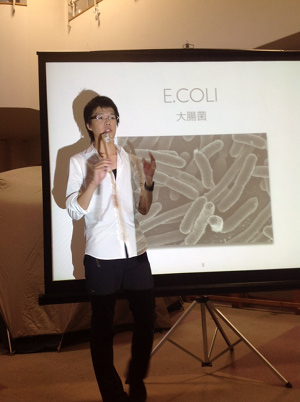
We went to Hibiya high school and Horikawa high school, and then we gave a short introduction on synthetic biology and iGEM, including the attractive points of synthetic biology, the ways of changing living things by reconstructing their genes and activities of other undergraduate iGEM teams.
In Japan, most high school student was not able to learn about synthetic biology and details of gene combination due to a regular curriculum of high school. This is why we decided to let them know how to conduct the experience, what synthetic biology is, and what iGEM is.
Furthermore we met some eager junior high school students, so we added a brief explanation about biochemistry, especially genes, nucleotide, codon and the basic system of gene expression.
We used these slides in order to teach synthetic biology.
The 3rd international symposium on liberal arts and general education
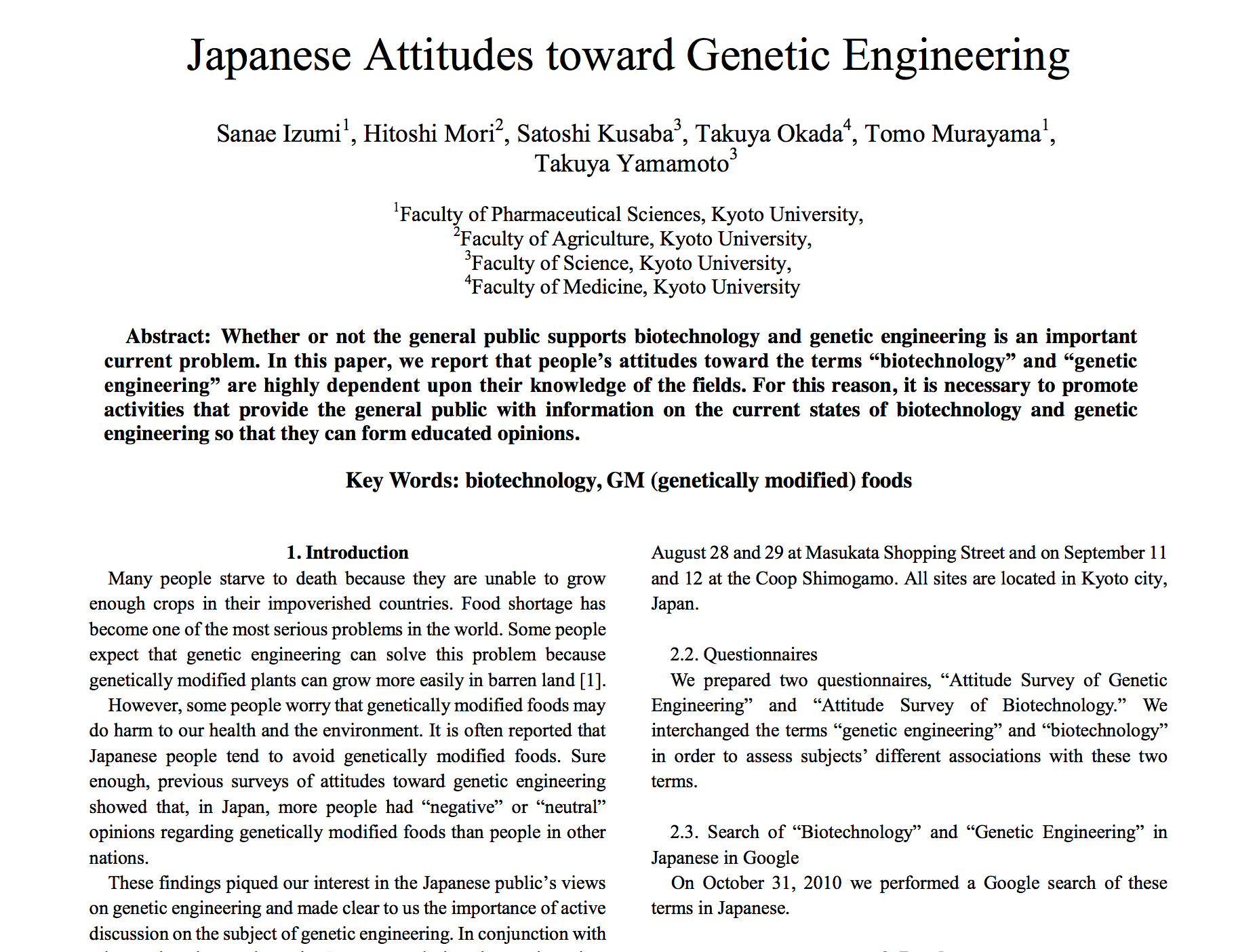
We wrote an article about "Japanese Attitude toward Genetic Engineering"
and presented it in the 2nd International Symposium on Liberal Arts and General Education which took place at Clock Tower Centennial Hall in Kyoto University, on November 23, 2011.
Many people starve to death because they are unable to grow enough crops in their impoverished countries. Food shortage has become one of the most serious problems in the world. Some people expect that genetic engineering can solve this problem because genetically modified plants can grow more easily in barren land .
However, some people worry that genetically modified foods may do harm to our health and the environment. It is often reported that Japanese people tend to avoid genetically modified foods. Sure enough, previous surveys of attitudes toward genetic engineering showed that, in Japan, more people had “negative” or “neutral” opinions regarding genetically modified foods than people in other nations.
These findings piqued our interest in the Japanese public’s views on genetic engineering and made clear to us the importance of active discussion on the subject of genetic engineering. In conjunction with other university students in Japan, we designed questionnaires asking for subjects’ impressions of genetic engineering and carried out a nationwide survey in order to clarify the reasons for Japanese people’s attitudes toward the subject .
In this paper, we suggest that educational differences have created a gap between the attitudes of students and adults of their parents generation.
read more:File:ENGLISH.pdf
Walk-in science
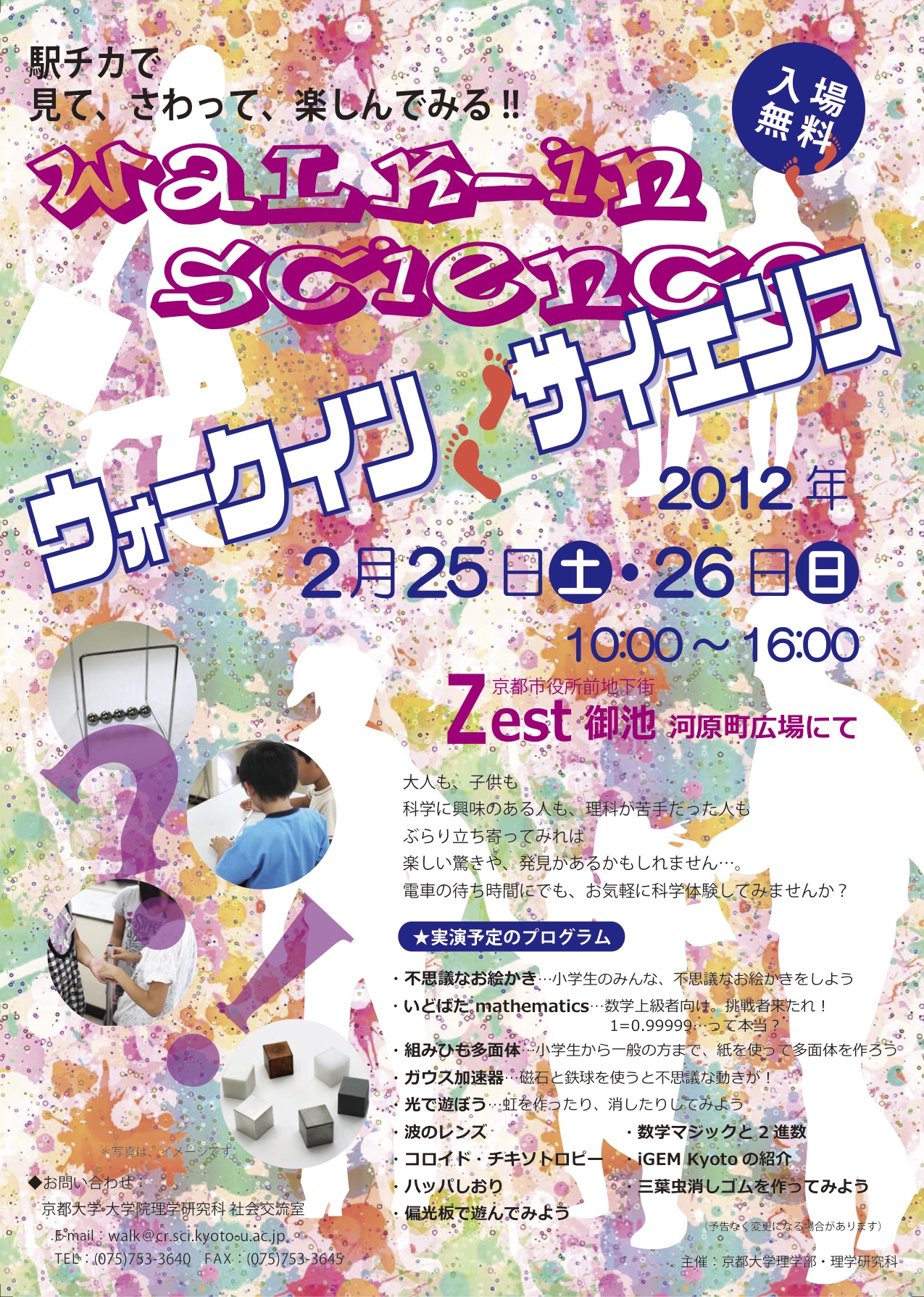
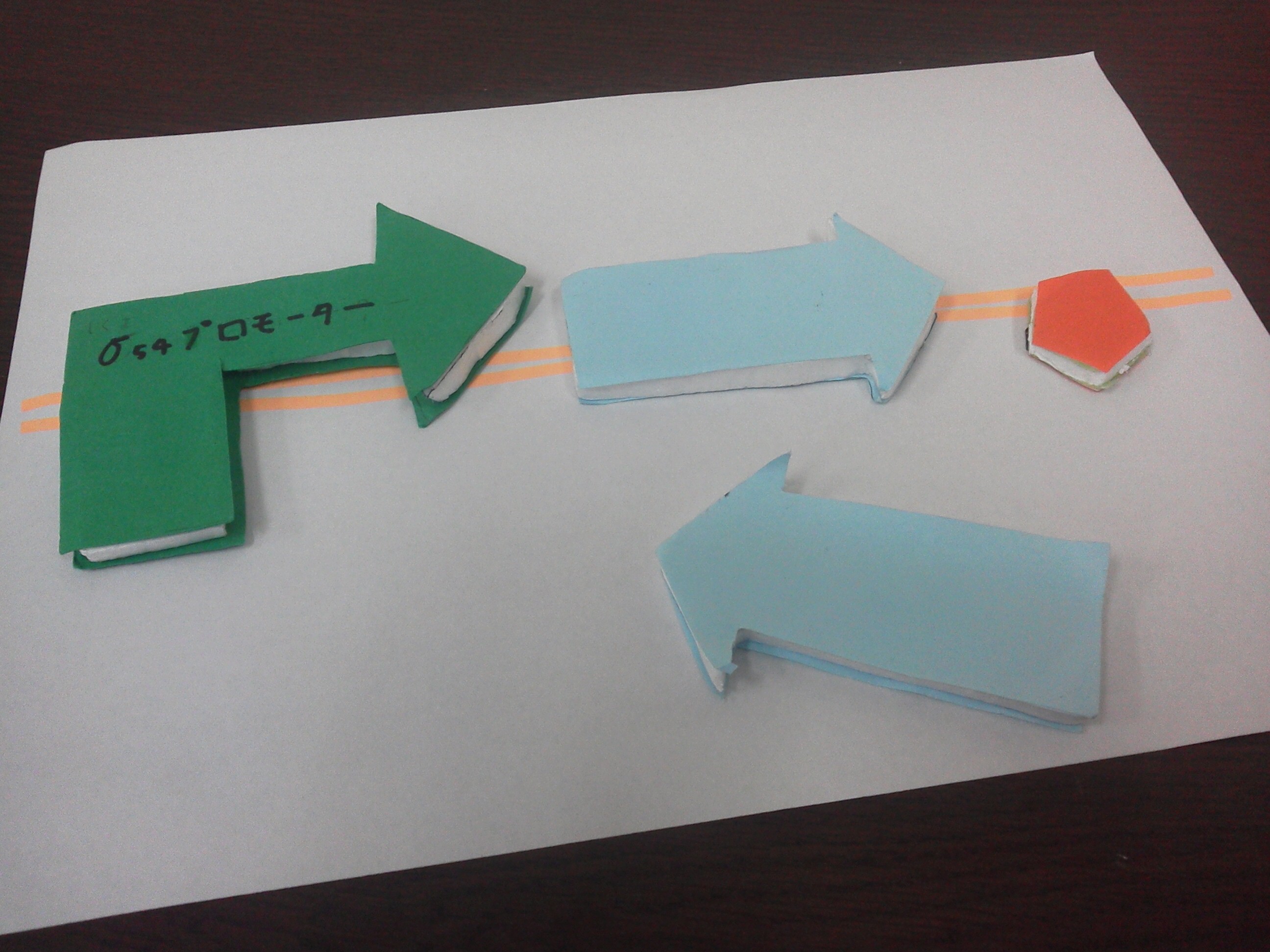
The Faculty of Science, Kyoto University, held "Walk-in Science," a science communication event at Kyoto City Hall Station in February 25 & 26. We iGEM Kyoto also joined it and ran a booth of synthetic biology.
Today, it is a problem in Japan that more young people are moving away from the sciences. Hence, it is important to let people, especially children, know more about sciences.
"Walk-in Science" was an event to show what we study, how interesting sciences are, to people who walk in non-academic place. "Walk-in Science" joiners had booths on the street of the underground mall.
To walkers of all ages who live in Kyoto, we told what Biobrick is, with "BioBrick Blocks".
Although most of them did not know about biotechnology, everyone listened to our speech and enrich their understanding.
Kyoto University Academic Day
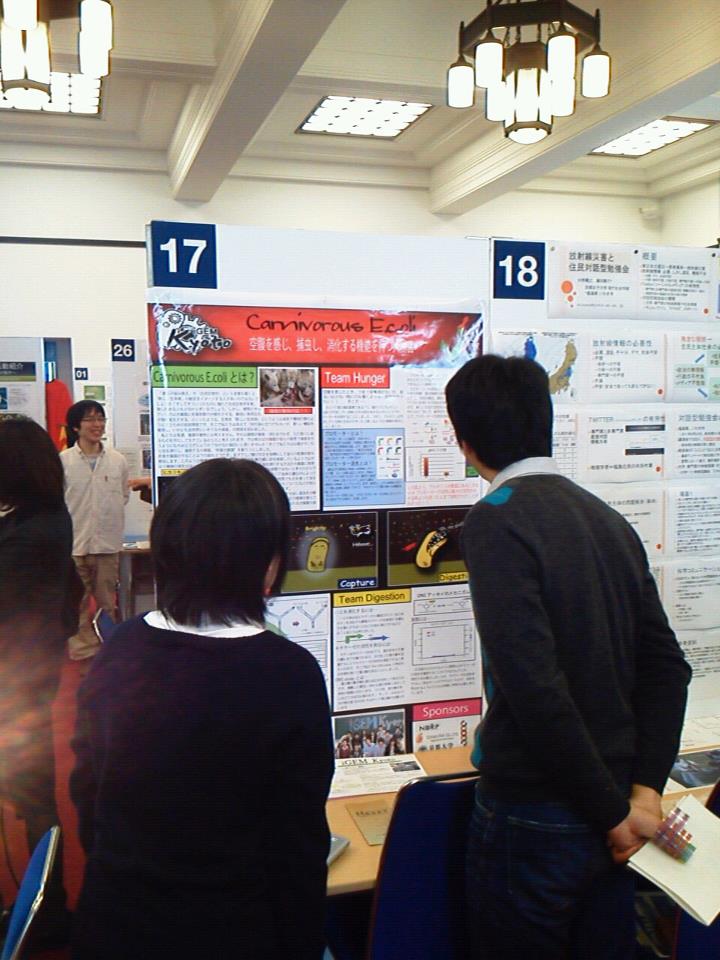
Kyoto University Academic Day is a place of communication that anyone can notice the attractiveness of learning fun regardless of Citizens and researchers.
The main purpose of this event is to reflect public opinion in national policy and research activities in the university.
Actually we used a poster and a screen to tell how to conduct an experiment of gene recombination, what "iGEM" is, and our results of research to children, housewives, teachers, and so on, then we could communicate and explain it with the people who don't know about "iGEM".
After our presentation many people said "I have had a bad impression on gene recombination and gene modified crops but today I heard the possibility of gene recombination and Synthetic biology, then I change my root thought about it"
November Festival and Open Campus at Kyoto University
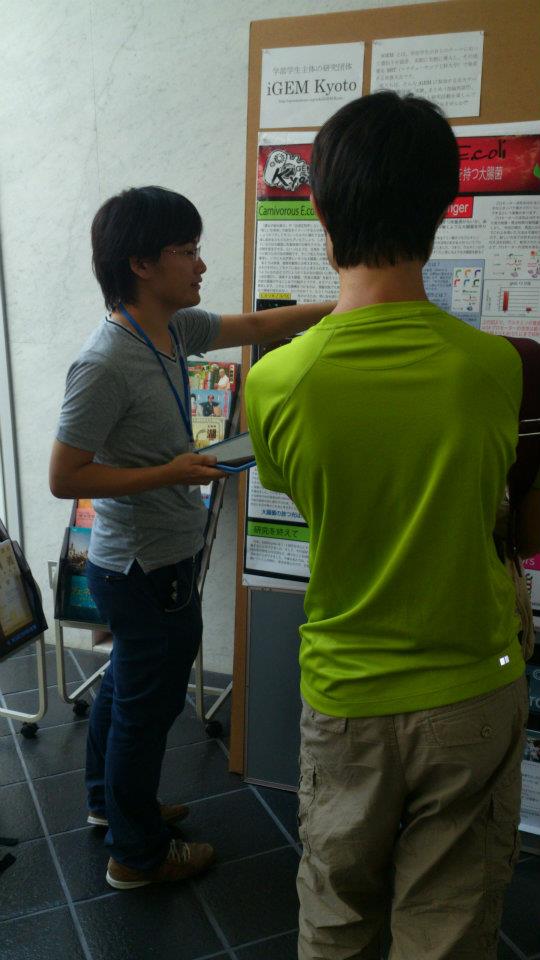
Kyoto University has some big events for people out of our university. We iGEM Kyoto joined two of those events: November Festival(NF) and Open Campus.
November Festa. is one of the biggest college festivals in West-Japan. It is held in 4 days, and many people of all ages come not only from Kyoto City but also from far away. In this festa. we presented what our team does in iGEM 2011 with a poster. We also explained what synthetic biology and iGEM are.
Kyoto University's Open Campus was held in August 9 & 10.
Many high school students visited our univ.
We talked with them about iGEM as one of the activities which college students can join.
We believe that some of them will join iGEM in the future.
Science Agora
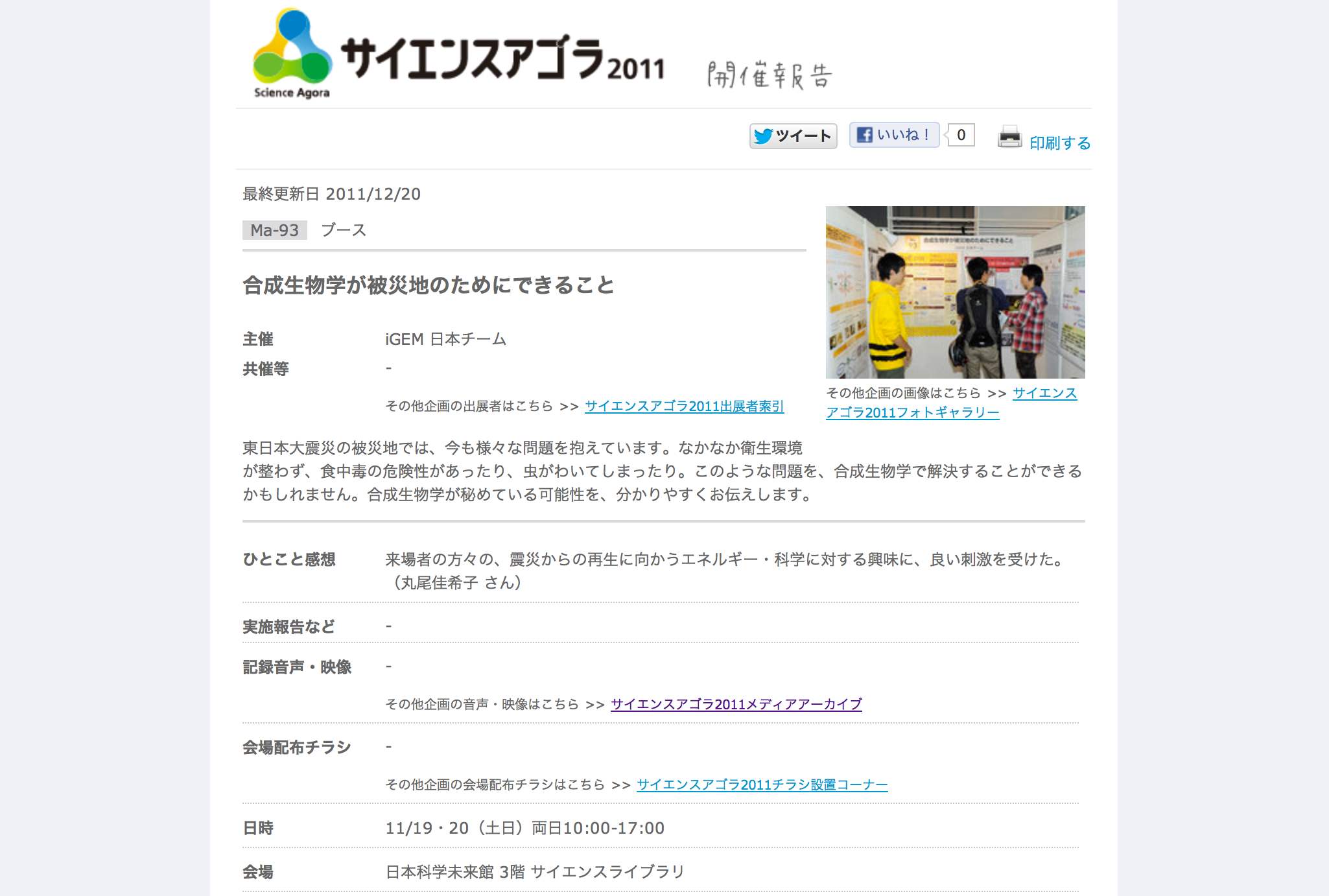
"Science agora" is the biggest event in Japan about science. Last year, we exhibited our results of research that we created "carnivorous E.coli" and "Flower Fairy E.coli" as a member of iGEM Japan. In Science agora, a variety of people with various backgrounds were there. Many children learned about synthetic biology here, and we communicated with many people.
Tie-up with Super Science High school
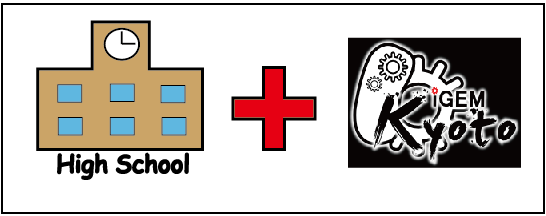
We began to communicate with students and teachers of Toyonaka high school.
Toyonaka high school is authorized Super Science High School by Ministry of Education, Culture, Sports, Science and Technology, and conduct a policy that they will increase the number of students who learn university-level education in biology.
As a one of the program, we decided to conduct the lecture that let them get into synthetic biology and experimental technique.
We will be having the lecture about synthetic biology for three days in November.
We thought this activity has several meaning that we are able to encourage regional development of science and technology and diffuse synthetic biology.
We would like to continue a communication like this.
Cooperation -a meeting in iGEM Japan-
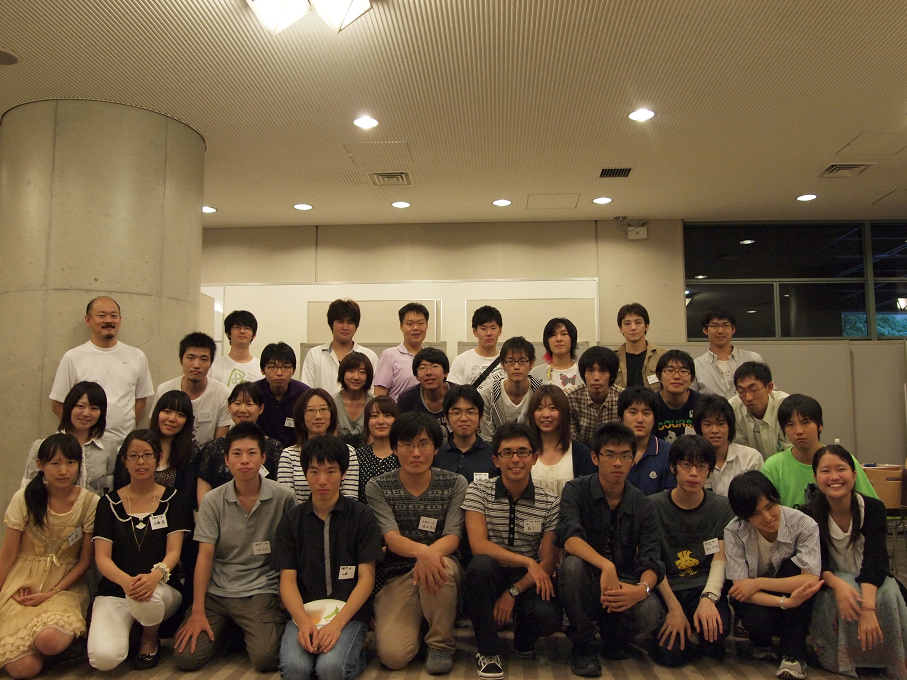
In Japan, there are more than 10 teams, so communication with other Japanese teams is very important to make our activities better. This summer, we held a meeting of iGEM Japan at Tokyo Metropolitan University. Each team presented and discussed its theme with other teams. Moreover we held an online meeting among iGEM teams in Japan and practiced presentations.
Cooperation with KAIT_Japan on issues of safety.
KAIT_Japan has an issue of safety. When we were trying some program which could make our research safer, we got their proposal about safety. They performed "Safety Icon Project".In this project, they designed icons in safety, which you could tell whether the parts in registry were safety or not at a glance. You can see the explanation of the icons and their meanings here.
Q1. Would any of your project ideas raise safety issues in terms of: researcher safety, public safety, or environmental safety?
We use the following creatures and genes.
・Creatures
- Arabidopsis thaliana
- Escherichia coli
・Genes
- TatABCD operon
- TAMO reductase
- TorA signal
- pspA
- kil
- FLOWERING LOCUS T
- others in iGEM Parts Kit
FLOWERING LOCUS T is derived from Arabidopsis thaliana and other all genes expect for iGEM Parts Kit are derived from E.coli. All experiments are conducted under the Biosafety level 1 control. All of rubbish containing recombinant E.coli is not carried out of our Lab before being sterilized. We always take care to lock the door of our Lab when there is no person so that the possibility that someone goes into our Lab and takes away recombinant cells is very low.
We are trained in applicable lab safety to ensure researcher safety and environmental safety. The researchers have also been trained in proper usage of chemicals and equipment. Some of the biological reagents and experiments necessary for the project needed safety measures. They were; Ethidium Bromide (EtBr), phenol, chloroform, 3,5-dinitrosalicylic acid, gas burner, ultra violet LED, polyacrylamide, 2-mercaptoethanol, PFA. Therefore, all researchers keep following rules when we use the chemicals or equipment above.
- EtBr (Ethidium bromide): EtBr is regarded as a mutagen, carcinogen or teratogen. Lab members were briefed on the possible effects of EtBr. During the experiments, we wore gloves. After use, the gloves and gel were separately disposed.
- Phenol and 3,5-Dinitrosalicylic Acid: Phenol and its vapors are corrosive to eyes, skin, and respiratory tract. 3,5-Dinitrosalicylic acid can cause serious irritation to eyes. These were handled under the draft chamber.
- Chloroform: Chloroform is a possible carcinogen. To avoid unnecessary exposure, this was also handled under the draft chamber.
- Gas Burner: We used gas burners and heated the air around the workspace to raise the temperature, thereby reducing contamination. Although the gas burner is a common combustion apparatus we are all familiar with, it can cause a massive disaster if used improperly. We made all-out efforts to keep all the flammable items away from the flame and not to pass behind a person who is using a gas burner.
- Ultra Violet LED: Ultra violet (UVB) is harmful to eyes. Hence, the LEDs were lit only inside the cardboard box and we only look at it to check if it is properly lit to avoid long exposure.
- polyacrylamide, 2-mercaptoethanol: We used these reagents for Western Blotting. They are toxic even though they are necessary to check the expression of target proteins so we asked for advice on how we should store them and obeyed the rules of Kyoto University.
- PFA: These reagents are used to microscope E.coli by Confocal laser scanning microscopy. This is usually stored in Prof. Agata’s Laboratory
Q2. Do any of the new BioBrick parts (or devices) that you made this year raise any safety issues?
- NO. Currently we have no BioBrick which raises any safety issues. The BioBricks we made this year are derived only from lab-safe strains of Arabidopsis thaliana and E.coli.
Q3. Is there a local biosafety group, committee, or review board at your institution?
Yes. We submitted the experiment plan to the Environment, Safety, and Health Organization, Kyoto Univ. (http://www.esho.kyoto-u.ac.jp/index.php) and were allowed to operate genetic modification of the bacteria under the Biosafety level 1(. Experiments were planned following the safety guidelines of the university (http://www.esho.kyoto-u.ac.jp/wp-content /uploads/2008/05/25_01.pdf). These guidelines are based on national laws and this includes several regulations on GMOs (http://www.bch.biodic.go.jp/hourei1.html). We carried out our experiments in the students-laboratory of the Graduate School of Science / Faculty of Science, Kyoto Univ, which has its own department for safety and environment. All of the lab members received training for PCR, culture of cells, miniprep and etc., the minimal genetical operations and use of autoclave.
Q4. Do you have any other ideas how to deal with safety issues that could be useful for future iGEM competitions? How could parts, devices and systems be made even safer through biosafety engineering?
IGEMers should set up a common clear biosafety regulation in iGEM competition and establish a systematic guideline of education about biosafety. This education should include information about biohazard and biotechnology risk assessment and risk analysis.
Backgrounds of iGEMers have become wider and wider, from high school students to graduate student in biology and from major in physics to major in molecular biology. For some students, iGEM is the first contact to genetic engineering and they have little knowledge of biohazard and importance of biosafety. Each iGEM teams, of course, teaches the knowledge to their members. However, a systematic education way of biosafety will help students to understand biosafety and to conduct their experiments more adequately.
From these reasons, we recommend that iGEM establish a systematic guideline of education about biosafety.
We work together with KAIT_Japan on issues of safety.
Cooperatively with KAIT_Japan, We iGEM Kyoto placed icons on our Wiki, which immediately enable you to see a risk of parts. The icons are as follows:
- Bio safety level 1:http://partsregistry.org/Image:Biosafety_Level1.png
- Bio safety level 2:http://partsregistry.org/Image:Biosafety_Level2.png
- Bio safety level 3:http://partsregistry.org/Image:Biosafety_Level3.png
- cases which affect biological community: http://partsregistry.org/Image:Biocenosis.png
- cases which affect the environment: http://partsregistry.org/Image:Environment.png
- cases which affect human bodies: http://partsregistry.org/Image:Humanbody.png
- cases which includes a certain risk because of mutations: http://partsregistry.org/Image:Mutation.png
- safe: http://partsregistry.org/Image:Safety.png
iGEM Kyoto 2012 team wouldn't have been able to do much without the lots of support of great advice and attributions. Thank you very much from the bottom of our heart.
Thank you for providing lots of advice on techniques and helping us to solve scientific problem.
- Knut Woltjen
Center for iPS Cell Research and Application(CiRA). Kyoto University
- Humihiko Satou
Graduate School of Biostudies. Kyoto University
- Takayuki Kouchi
Graduate School of Biostudies. Kyoto University
- Toru Matou & Masaru Kobayashi
Faculty/Graduate School of Agriculture
- Takashi Endou
Faculty/Graduate School of Agriculture
- Tan Inoue
Graduate School of Biostudies. Kyoto University
- Ken Kajita
Faculty of Engineering. Kyoto University
- Tatsuya Hirose
Faculty of Science. Kyoto University
Thank you for letting us use laboratory and seminar room over the summer vacation and use freely expensive laboratory equipment.
- Kyoto University Committee, Faculty of Science Building #2
Attribution
Thank you for providing of Flower Locus T Plasmid.
- Takashi Araki
[http://www.lif.kyoto-u.ac.jp/labs/plantdevbio/index.html Laboratory of Plant Deveropmental Biology]
2007 Plant Developmental Biology, Graduate School of BIOSTUDIES, Kyoto-Univ.
Thank you for providing of Arabidopsis thaliana.
- Tetsuro Okuno
Graduate School of Agriculture, Kyoto Univ.
- Kojiro Takanashi
Research Institute for Sustainable Humanosphere, Kyoto Univ.
- Sota Fujii
Graduate School of Science, Kyoto Univ.
- Toshiharu Shikanai
Graduate School of Science, Kyoto Univ.
Thank you for providing of reagents.
- Yasuo Mori
Graduate Scholl of Engineering, Kyoto Univ.
Thank you for providing of MilliQ and EtBr.
- Tokitaka Oyama
Department of Botany, Graduate School of Science, Kyoto Univ.
Thank you for providing of Arabidopsis thaliana and Syringe.
- Ikuko Nishimura
Department of Botany, Kyoto Univ
- Tomonori Takada
Department of Botany, Kyoto Univ
Thank you for providing us of Arabidopsis thaliana.
- Ikuhiko Nakase
Graduate School of Pharmaceutical Sciences, Kyoto-Univ.
Thank you for your supervising of our using confocal microscope and liquid nitrogen.
- Makoto Kashima
Graduate School of Science, Kyoto Univ
Thank you for your supervising of our purification of protein.
- Wataru Shihoya
Cellular and Structural Physiology Institute, Nagoya University
Kyoto University is our school and supports us.

Integrated DNA Technologies (IDT), Japanese branch, Medical & Biological Laboratories Company (MBL), Leave a Nest supported us.

File:MBLlogo.gif

CosmoBio supported us financially.

 "
"









